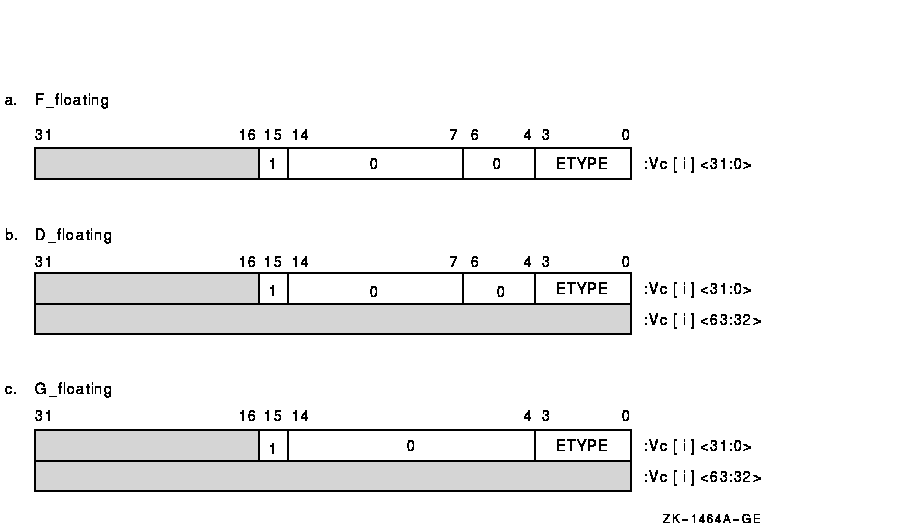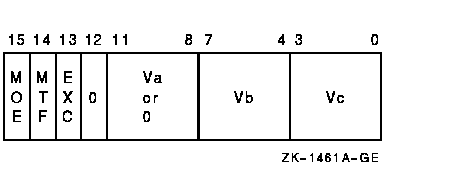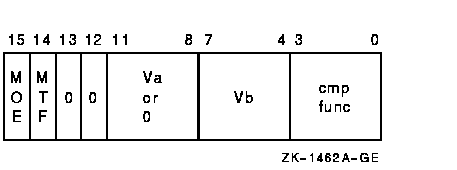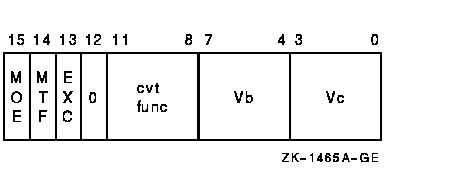VAX MACRO and Instruction Set Reference Manual
10.13 Vector Floating-Point Instructions
The VAX vector architecture provides instructions for operating on
F_floating, D_floating, and G_floating operand formats. The
floating-point arithmetic instructions are add, subtract, compare,
multiply, and divide. Data conversion instructions are provided to
convert operands between D_floating, G_floating, F_floating, and
longword integer.
Rounding is performed using standard VAX rounding rules. The accuracy
of the vector floating-point instructions matches that of the scalar
floating-point instructions. Refer to the section on floating-point
instructions in the VAX Architecture Reference Manual for more information.
10.13.1 Vector Floating-Point Exception Conditions
All vector floating-point exception conditions occur asynchronously
with respect to the scalar processor. These exception conditions do not
interrupt the scalar processor. If the exception condition is enabled,
then the exception condition type and destination register number are
recorded in the Vector Arithmetic Exception Register (VAER), and a
reserved operand in the format of the instruction's data type is
written into the destination register element. Encoded in this reserved
operand is the exception condition type. After recording the exception
and writing the appropriate result into the destination register
element, the instruction encountering the exception continues executing
to completion.
If a vector convert floating to integer instruction encounters a source
element that is a reserved operand, an UNPREDICTABLE result rather than
a reserved operand is written into the destination register element.
Figure 10-13 shows the encoding of the reserved operand that is
written for vector floating-point exceptions. Consistent with the
definition of a reserved operand, the sign bit (bit <15>) is one
and the exponent (bits <14:7> for F_floating and D_floating, and
bits <14:4> for G_floating) is zero. When the reserved operand is
written in F_floating or D_floating format, bits <6:4> are also
zero. The exception condition type (ETYPE) is encoded in bits
<3:0>, as shown in Table 10-16. If a reserved operand is
divided by zero, both ETYPE bits may be set. The state of all other
bits in the result (denoted by shading) is UNPREDICTABLE.
If the floating underflow exception condition is suppressed by
cntrl<EXC>, a zero result is written to the destination register
element and no further action is taken. Floating overflow, floating
divide by zero, and floating reserved operand are always enabled.
Figure 10-13 Encoding of the Reserved Operand

10.13.2 Floating-Point Instructions
This section describes VAX vector architecture floating-point
instructions.
VADD
Vector Floating Add
Format
vector + vector:
{VVADDF|VVADDD|VVADDG} [/U[0|1]] Va, Vb, Vc
scalar + vector:
{VSADDF|VSADDD|VSADDG [/U[0|1]] scalar, Vb, Vc
Architecture
Format
vector + vector:
opcode cntrl.rw
scalar + vector (F_floating):
opcode cntrl.rw, addend.rl
scalar + vector (D_ and G_floating):
opcode cntrl.rw, addend.rq
Opcodes
|
84FD
|
VVADDF
|
Vector Vector Add F_Floating
|
|
85FD
|
VSADDF
|
Vector Scalar Add F_Floating
|
|
86FD
|
VVADDD
|
Vector Vector Add D_Floating
|
|
87FD
|
VSADDD
|
Vector Scalar Add D_Floating
|
|
82FD
|
VVADDG
|
Vector Vector Add G_Floating
|
|
83FD
|
VSADDG
|
Vector Scalar Add G_Floating
|
vector_control_word

Exceptions
floating overflow
floating reserved operand
floating underflow
Description
The source addend or vector operand Va is added, elementwise, to vector
register Vb and the sum is written to vector register Vc. The length of
the vector is specified by the Vector Length Register (VLR).
In VxADDF, only bits <31:0> of each vector element participate in
the operation. Bits <63:32> of the destination vector elements
are UNPREDICTABLE.
If a floating underflow occurs when cntrl<EXC> is set or if a
floating overflow or floating reserved operand occurs, an encoded
reserved operand is stored as the result and the exception condition
type and destination register number are recorded in the Vector
Arithmetic Exception Register (VAER). The vector operation is then
allowed to complete. If cntrl<EXC> is clear, zero is written to
the destination element when an exponent underflow occurs and no other
action is taken.
VCMP
Vector Floating Compare
Format
vector--vector:
{VVGTRF|VVGTRD|VVGTRG|VVEQLF|VVEQLD|
VVEQLG|VVLSSF|VVLSSD|VVLSSG|VVLEQF|VVLEQD|
VVLEQG|VVNEQF|VVNEQD|VVNEQG|VVGEQF|VVGEQD|VVGEQG} [/U[0|1]] Va, Vb
scalar--vector:
{VSGTRF|VSGTRD|VSGTRG|VSEQLF|VSEQLD|
VSEQLG|VSLSSF|VSLSSD|VSLSSG|VSLEQF|VSLEQD|
VSLEQG|VSNEQF|VSNEQD|VSNEQG|VSGEQF|VSGEQD|VSGEQG} [/U[0|1]] src, Vb
Architecture
Format
vector--vector:
opcode cntrl.rw
scalar--vector (F_floating):
opcode cntrl.rw, src.rl
scalar--vector (D_ and G_floating):
opcode cntrl.rw, src.rq
Opcodes
|
C4FD
|
VVCMPF
|
Vector Vector Compare F_floating
|
|
C5FD
|
VSCMPF
|
Vector Scalar Compare F_floating
|
|
C6FD
|
VVCMPD
|
Vector Vector Compare D_floating
|
|
C7FD
|
VSCMPD
|
Vector Scalar Compare D_floating
|
|
C2FD
|
VVCMPG
|
Vector Vector Compare G_floating
|
|
C3FD
|
VSCMPG
|
Vector Scalar Compare G_floating
|
vector_control_word

The condition being tested is determined by cntrl<2:0>, as
follows:
| Value of cntrl<2:0> |
Meaning |
|
0
|
Greater than
|
|
1
|
Equal
|
|
2
|
Less than
|
|
3
|
Reserved
1
|
|
4
|
Less than or equal
|
|
5
|
Not equal
|
|
6
|
Greater than or equal
|
|
7
|
Reserved
1
|
1Vector integer compare instructions that specify reserved
values of cntrl<2:0> produce UNPREDICTABLE results.
Note
Cntrl<3> should be zero; if it is set, the results of the
instruction are UNPREDICTABLE.
|
Exceptions
floating reserved operand
Description
The scalar or vector operand Va is compared, elementwise, with vector
register Vb. The length of the vector is specified by the Vector Length
Register (VLR). For each element comparison, if the specified
relationship is true, the Vector Mask Register bit (VMR<i>)
corresponding to the vector element is set to one, otherwise it is
cleared. If cntrl<MOE> is set, VMR bits corresponding to elements
that do not match cntrl<MTF> are left unchanged. VMR bits beyond
the vector length are left unchanged. If an element being compared is a
reserved operand, VMR<i> is UNPREDICTABLE. In VxCMPF, only bits
<31:0> of each vector element participate in the operation.
If a floating reserved operand exception occurs, the exception
condition type is recorded in the Vector Arithmetic Exception Register
(VAER) and the vector operation is allowed to complete.
Note that for this instruction, no bits are set in the VAER destination
register mask when an exception occurs.
VVCVT
Vector Convert
Format
{VVCVTLF|VVCVTLD|VVCVTLG|VVCVTFL|VVCVTRFL|
VVCVTFD|VVCVTFG|VVCVTDL|VVCVTDF| VVCVTRDL|VVCVTGL|VVCVTGF|VVCVTRGL}
[/U[0|1]] Vb, Vc
Architecture
Format
opcode cntrl.rw
Opcodes
|
ECFD
|
VVCVT
|
Vector Convert
|
vector_control_word

Cntrl<11:8> specifies the conversion to be performed, as follows:
| cntrl<11:8> |
Meaning |
|
1 1 1 1
|
CVTRGL (Convert Rounded G_Floating to Longword)
|
|
1 1 1 0
|
Reserved
1
|
|
1 1 0 1
|
CVTGF (Convert Rounded G_Floating to F_Floating)
|
|
1 1 0 0
|
CVTGL (Convert Truncated G_Floating to Longword)
|
|
1 0 1 1
|
Reserved
1
|
|
1 0 1 0
|
CVTRD (Convert Rounded D_Floating to Longword)
|
|
1 0 0 1
|
CVTDF (Convert Rounded D_Floating to F_Floating)
|
|
1 0 0 0
|
CVTDL (Convert Truncated D_Floating to Longword)
|
|
0 1 1 1
|
CVTFG (Convert F_Floating to G_Floating (exact))
|
|
0 1 1 0
|
CVTFD (Convert F_Floating to D_Floating (exact))
|
|
0 1 0 1
|
CVTRF (Convert Rounded F_Floating to Longword)
|
|
0 1 0 0
|
CVTFL (Convert Truncated F_Floating to Longword)
|
|
0 0 1 1
|
CVTLG (Convert Longword to G_Floating (exact))
|
|
0 0 1 0
|
CVTLD (Convert Longword to D_Floating (exact))
|
|
0 0 0 1
|
CVTLF (Convert Rounded Longword to F_Floating)
|
|
0 0 0 0
|
Reserved
1
|
1Vector convert instructions that specify reserved values of
cntrl<11:8> produce UNPREDICTABLE results.
Exceptions
floating overflow
floating reserved operand
floating underflow
integer overflow
Description
The vector elements in vector register Vb are converted and results are
written to vector register Vc. Cntrl<11:8> specifies the
conversion to be performed. The length of the vector is specified by
the Vector Length Register (VLR). Bits <63:32> of Vc are
UNPREDICTABLE for instructions that convert from D_floating or
G_floating to F_floating or longword. When CVTRGL, CVTRDL, and CVTRFL
round, the rounding is done in sign magnitude, before conversion to
two's complement.
If an integer overflow occurs when cntrl<EXC> is set, the
low-order 32 bits of the true result are written to the destination
element as the result, and the exception condition type and destination
register number are recorded in the Vector Arithmetic Exception
Register (VAER). The vector operation is then allowed to complete. If
integer overflow occurs when cntrl<EXC> is clear, the low-order
32 bits of the true result are written to the destination element, and
no other action is taken.
For vector convert floating to integer, where the source element is a
reserved operand, the value written to the destination element is
UNPREDICTABLE. In addition, the exception type and destination register
number are recorded in the VAER. The vector operation is then allowed
to complete.
For vector convert floating to floating instructions, if floating
underflow occurs when cntrl<EXC> is clear, zero is written to the
destination element, and no other action is taken. The vector operation
is then allowed to complete.
For vector convert floating to floating instructions, if floating
underflow occurs with cntrl<EXC> set or if a floating overflow or
reserved operand occurs, an encoded reserved operand is written to the
destination element, and the exception condition type and destination
register number are recorded in the VAER. The vector operation is then
allowed to complete.
VDIV
Vector Floating Divide
Format
vector/vector:
{VVDIVF|VVDIVD|VVDIVG} [/U[0|1]] Va, Vb, Vc
scalar/vector:
{VSDIVF|VSDIVD|VSDIVG} [/U[0|1]] scalar, Vb, Vc
Architecture
Format
vector/vector:
opcode cntrl.rw
scalar/vector (F_floating):
opcode cntrl.rw, divd.rl
scalar/vector (D_ and G_floating):
opcode cntrl.rw, divd.rq
Opcodes
|
ACFD
|
VVDIVF
|
Vector Vector Divide F_floating
|
|
ADFD
|
VSDIVF
|
Vector Scalar Divide F_floating
|
|
AEFD
|
VVDIVD
|
Vector Vector Divide D_floating
|
|
AFFD
|
VSDIVD
|
Vector Scalar Divide D_floating
|
|
AAFD
|
VVDIVG
|
Vector Vector Divide G_floating
|
|
ABFD
|
VSDIVG
|
Vector Scalar Divide G_floating
|
vector_control_word

Exceptions
floating divide by zero
floating overflow
floating reserved operand
floating underflow
Description
The scalar dividend or vector register Va is divided, elementwise, by
the divisor in vector register Vb and the quotient is written to vector
register Vc. The length of the vector is specified by the Vector Length
Register (VLR).
In VxDIVF, only bits <31:0> of each vector element participate in
the operation; bits <63:32> of the destination vector elements
are UNPREDICTABLE.
If a floating underflow occurs when cntrl<EXC> is set or if a
floating overflow, divide by zero, or reserved operand occurs, an
encoded reserved operand is stored as the result and the exception
condition type and destination register number are recorded in the
Vector Arithmetic Exception Register (VAER). The vector operation is
then allowed to complete. If cntrl<EXC> is clear, zero is written
to the destination element when an exponent underflow occurs and no
other action is taken.
VMUL
Vector Floating Multiply
Format
vector * vector:
{VVMULF|VVMULD|VVMULG} [/U[0|1]] Va, Vb, Vc
scalar * vector:
{VSMULF|VSMULD|VSMULG} [/U[0|1]] scalar, Vb, Vc
Architecture
Format
vector * vector:
opcode cntrl.rw
scalar * vector (F_floating):
opcode cntrl.rw, mulr.rl
scalar * vector (D_ and G_floating):
opcode cntrl.rw, mulr.rq
Opcodes
|
A4FD
|
VVMULF
|
Vector Vector Multiply F_floating
|
|
A5FD
|
VSMULF
|
Vector Scalar Multiply F_floating
|
|
A6FD
|
VVMULD
|
Vector Vector Multiply F_floating
|
|
A7FD
|
VSMULD
|
Vector Scalar Multiply D_floating
|
|
A2FD
|
VVMULG
|
Vector Vector Multiply G_floating
|
|
A3FD
|
VSMULG
|
Vector Scalar Multiply G_floating
|
vector_control_word

Exceptions
floating overflow
floating reserved operand
floating underflow
Description
The multiplicand in vector register Vb is multiplied, elementwise, by
the scalar multiplier or vector operand Va and the product is written
to vector register Vc. The length of the vector is specified by the
Vector Length Register (VLR).
In VxMULF, only bits <31:0> of each vector element participate in
the operation. Bits <63:32> of the destination vector elements
are UNPREDICTABLE.
If a floating underflow occurs when cntrl<EXC> is set or if a
floating overflow or reserved operand occurs, an encoded reserved
operand is stored as the result and the exception condition type and
destination register number are recorded in the Vector Arithmetic
Exception Register (VAER). The vector operation is then allowed to
complete. If cntrl<EXC> is clear, zero is written to the
destination element when an exponent underflow occurs and no other
action is taken.
VSUB
Vector Floating Subtract
Format
vector--vector:
{VVSUBF|VVSUBD|VVSUBG} [/U[0|1]] Va, Vb, Vc
scalar--vector:
{VSSUBF|VSSUBD|VSSUBG} [/U[0|1]] scalar, Vb, Vc
Architecture
Format
vector--vector:
opcode cntrl.rw
scalar--vector (F_floating):
opcode cntrl.rw, min.rl
scalar--vector (D_ and G_floating):
opcode cntrl.rw, min.rq
Opcodes
|
8CFD
|
VVSUBF
|
Vector Vector Subtract F_floating
|
|
8DFD
|
VSSUBF
|
Vector Scalar Subtract F_floating
|
|
8EFD
|
VVSUBD
|
Vector Vector Subtract D_floating
|
|
8FFD
|
VSSUBD
|
Vector Scalar Subtract D_floating
|
|
8AFD
|
VVSUBG
|
Vector Vector Subtract G_floating
|
|
8BFD
|
VSSUBG
|
Vector Scalar Subtract G_floating
|
vector_control_word

Exceptions
floating overflow
floating reserved operand
floating underflow
Description
Vector register Vb is subtracted, elementwise, from the scalar minuend
or vector register Va and the difference is written to vector register
Vc. The length of the vector is specified by the Vector Length Register
(VLR).
In VxSUBF, only bits <31:0> of each vector element participate in
the operation; bits <63:32> of the destination vector elements
are UNPREDICTABLE.
If a floating underflow occurs when cntrl<EXC> is set or if a
floating overflow or reserved operand occurs, an encoded reserved
operand is stored as the result and the exception condition type and
destination register number are recorded in the Vector Arithmetic
Exception Register (VAER). The vector operation is then allowed to
complete. If cntrl<EXC> is clear, zero is written to the
destination element when an exponent underflow occurs and no other
action is taken.
|






